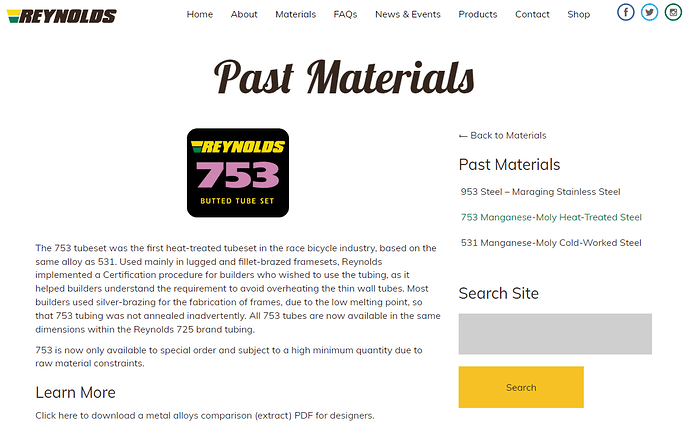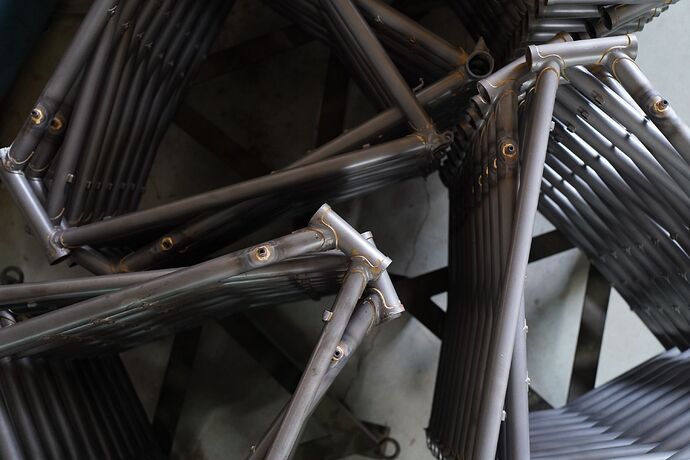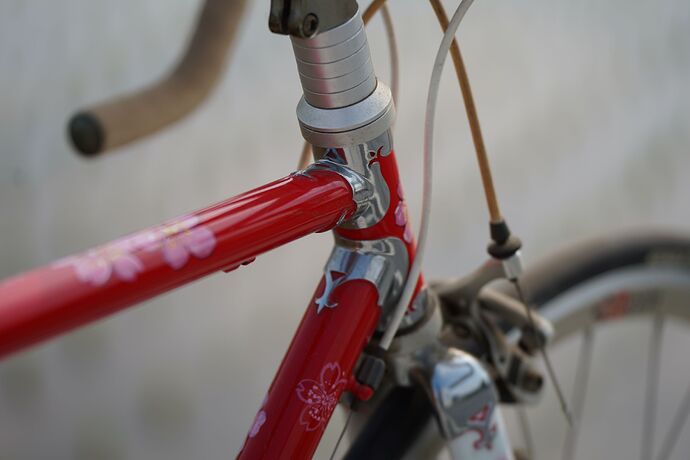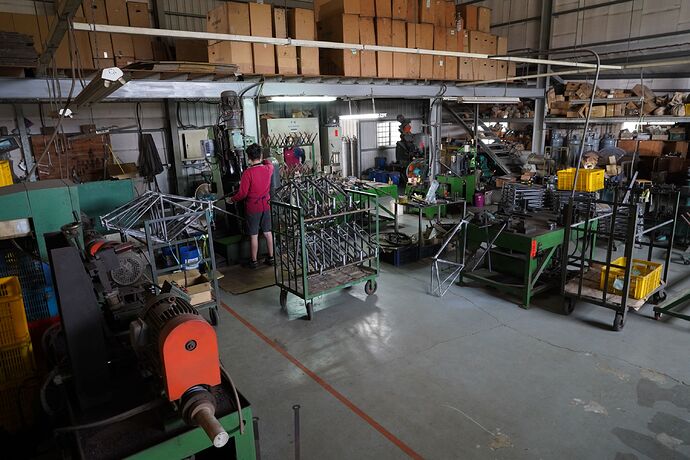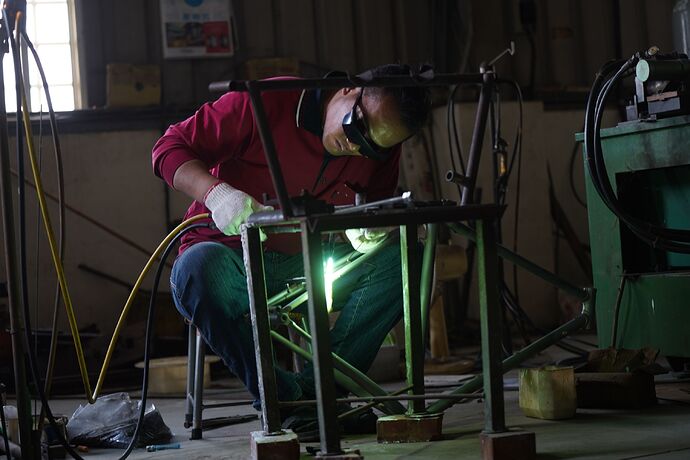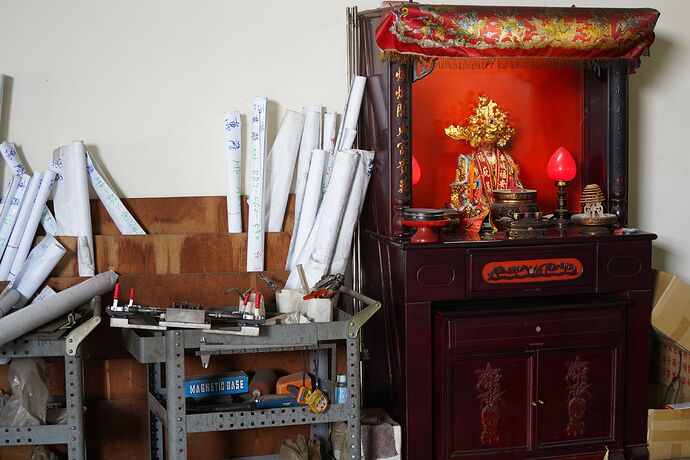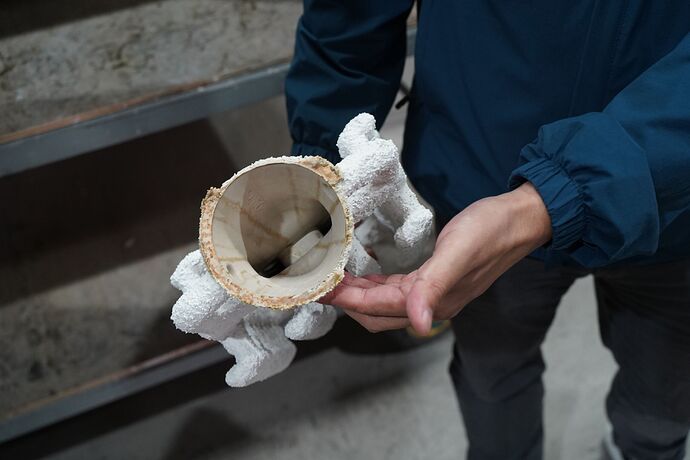Innovation in the bike industry is mostly driven by the needs of the big players. Do we need more innovation which is specifically for building steel frame using artisanal methods?
I think there is great work being done with 3d printing but do we need more innovation in other areas?
I know that fillet brazing and TIG are the joining methods of choice for most on this forum, but I’m suggesting that there needs to be a better selection of lugs. The older styles are well represented, but there need to be more lugs to accommodate sloping top tube designs - (a few more angles and tube diameters). It’s sad the one of the few lugsets for sloping, Llewellyn’s Manorina (Compact) for normal diameters/smaller frames seems to be unavailable. And yes, I know about the huge amount of design work required and mold costs . . .
Quick note: there are lugs designed for sloping TT. I suppose it’s more of a marketing/stocking issue. Download an Allotec catalog and scope out these lugs: F151/F150, F161/F160, F243/F242, and B140/B240. Alex Meade has a bottom HT lug for tapered HT/DOS DT.
Some suppliers (both in the US and overseas) offer versions these lugs, but not necessarily with angles for sloping TT. It’s worth asking if they’d add your desired angles to their next order.
I was communicating a month ago with Darrell McCulloch of Llewellyn and he has all models of lugs available ready to ship internationally.
Yes I think you’re right. Some builders have been actively producing items but we defintely need more options. Its true there are sloping top tube lugs for instance, but just one set of angles so they are quite limiting. Darrell’s are probably the best but the others i’ve used have probably been more hit an miss in terms of quality. Useable but need extra work.
Daccordi have also produced a lug for a tapered head tube, but they haven’t made theirs widely available.
There are bit and pieces available but more is needed I think. There is much more available to build a classic frame, but building a lugged frame for modern equipment always requires extra work custom work which puts lugged building at a disadvantage to other methods.
I think we have reached a pint now where we either produce items ourselves or some techniques will die out. I am going to look more into what i can get produced and I will make them available to all just as builders suchs as Sachs and MacCulloch have done.
However another area I think worth looking at again is tubing, which is optimised for for silver brazing. A kind of spiritual successor to 753.
I have read your article a few times now and it has risen an eyebrow or two in the process. Trying to write this as diplomatic as possible, but bear in mind that I am not a native speaker of the English language ![]()
So, the first statement you are making concerning the frame sizes limiting the individuality I have to agree on, but how would the quality be negatively affected by an industrial manufacturing process over hand built craftsmanship? From my understanding, one of the single most beneficial aspects of batch production is that you can have more control over your processes and in return get more consistent results. Something that is next to impossible to ensure in a one off artisanal production, even for the most skilled masters of the craft.
In the next paragraph it sounds to me as if you state the opinion that aluminium and carbon were only and solely chosen as a material for the ease of manufacturing. I disagree again; all materials have their unique set of characteristics which makes them more or less suitable for specific shapes, loads, techniques, environmental conditions in my books. From my point of view, there is no “best” material for a given task and a given set of requirements. Things that can be achieved with aluminium and composite technology cannot be achieved with steel and vice versa. It just depends on the prioorities of the given task which material you end up with. If your #1 priority is lowest mass or best stiffness to weight ratio, you’re going to have a hard time achieving competitive results with steel. If your priority is the sleek aesthetics of slender, straight tubes, aluminium might not be your best choice…
Basically, I have the feeling that most of the article goes in a similar direction and I think, it is a bit too one-dimensional, as if a silver brazed, lugged steel frame with the thinnest tubing possible would be the pinnacle of all bicycles and everything else is technically just cheaper to make at the expense of mechanical and artisanal greatness. The only thing holding us back from achieving this greatness is the greedy industry that is withholding from us the tubesets and lugs needed.
Don’t get me wrong, I do like lugged frames and I also think they have a place, especially in our cozy little framebuilding bubble. But I don’t necessarily think they should have the exclusive badge of “true artisanship” as you state in the finishing paragraph. That would devalue all the amazing projects using all kinds of different techniques showcased here on this forum!
Now, I hope I haven’t thrown down the gauntlet with my response, let me know what you think!
Sorry I didn’t intend it to say that lugged builders are the real artisans. I was really trying to start a discussion that the needs of artisan framebuilders are different from those of mass manufacturers.
Also these comments are aimed more at builders who make frames for individual customers rather than batch production which is a different kettle of fish.
“So, the first statement you are making concerning the frame sizes limiting the individuality I have to agree on, but how would the quality be negatively affected by an industrial manufacturing process over hand built craftsmanship? From my understanding, one of the single most beneficial aspects of batch production is that you can have more control over your processes and in return get more consistent results. Something that is next to impossible to ensure in a one off artisanal production, even for the most skilled masters of the craft.”
Our advantage is in creating a personalised bike, and includes tuning the construction to the individual person. I wouldn’t build the same frame for someone who has a bigger build and is an aggressive rider, compared to someone more diminutive who is a smooth pedaler (in my example I’m assuming both riders have the same dimensions). That is the advantage over a mass produced bike. Mass produced bikes have to be strong enough and perform for the more aggressive bigger rider and the smaller rider is short changed. But that is the same with any mass produced or even batch produced product.
“In the next paragraph it sounds to me as if you state the opinion that aluminium and carbon were only and solely chosen as a material for the ease of manufacturing. I disagree again; all materials have their unique set of characteristics which makes them more or less suitable for specific shapes, loads, techniques, environmental conditions in my books. From my point of view, there is no “best” material for a given task and a given set of requirements. Things that can be achieved with aluminium and composite technology cannot be achieved with steel and vice versa. It just depends on the prioorities of the given task which material you end up with. If your #1 priority is lowest mass or best stiffness to weight ratio, you’re going to have a hard time achieving competitive results with steel. If your priority is the sleek aesthetics of slender, straight tubes, aluminium might not be your best choice…”
Are you saying that ease of manufacturer has no bearing on the direction of innovation?
Don’t worry about throwing down the gauntlet. Some of the article can be taken as tongue in cheek. Aftercall steel lugged frames are often labelled antique technology.
What I am really arguing for is that some processes were ditched because they are to laborious for mass production and not because they didn’t have merit. And maybe we should look to expand the materials we build with, while having an eye on the processes that suit a custom builder rather than a mass production environment.
I appreciate your comments though!
Haha no, not at all! I am just trying to make the argument that every product that is developed, at the end of the day, is reflecting the individual combination of the priorities and other boundary conditions (batch size, access to materials/processes…) defined before the development.
Of course ease of manufacturing has a higher bearing on the direction of industrial innovation, simply because of the economies of scale. Larger corporations rarely do anything because they just think it looks cool ![]()
On the other hand though… I’m sure you must have seen this video about the panasonic individual custom system “PICS” which kind of ticks all the boxes AND is about as easy to produce a frame as possible (on an industrial scale). So maybe there were a few other factors involved in ditching the process of lugged frame building?
I don’t have anything to add to this discussion. I just wanted to say I’ve never seen that video before and it’s awesome. The octopus looking brazing setup at 7:30 is the coolest thing ever! It’s looks like something a mad scientist in a movie would use.
Yes I have seen that video. I think Panasonic are quite unique in how far they pushed manufacturing of lugged steel frames. It is impressive, probably more so than the Giant factory today. Perhaps that proves my point about jut how complicated (expensive) a set up is needed to mass produced lugged frames at a high quality, with that level of customisation.
However I think your missing the point of my post. Are we settling for the materials that are available to us as steel framebuilders or is there scope for improvement. The reason i brought mass production into was to point out that I don’t know of any current large scale producers of steel frames that are asking for tubing optimized for silver brazing and lugs and that it may be worth continuing down the trajectory that Reynolds started with 753.
Ok so after thinking about it I do want to participate in the discussion haha.
I believe it’s true that large companies will look to maximize capital over all else. As you mentioned, lean, large scale manufacturing practice is a way to lower cost and increase profit. I also believe that maximizing demand and sales increases profits even more.
I believe that bicycling is mostly a consumer driven market. At least where I live in the US, enthusiast cyclists are largely interested in performance and racing. Because of that, large companies focus on performance when marketing and developing bikes. Maybe you disagree, but I think for raw speed carbon has shown itself to be the ideal material for bike frames. The option for large companies to use cheap labor overseas is just a bonus.
Now I do believe this “need for speed” by cycling consumers is somewhat driven by marketing. I see lots of people on carbon race bikes that would be much better off on a steel commuter bike, and I have to try not to roll my eyes when the topic of bike weight comes up. I just think there’s many more cultural/ societal factors involved beyond “cyclists will just buy whatever companies tell them.”
There has been a recent and steady change in cycling culture that I’ve observed (in the US) with a growing popularity in bike touring and non-competitive cycling. With that, steel seems to be making a comeback as well. I do hope and believe we will see innovation in steel bike materials, design and manufacturing in the future. I doubt it will be performance (speed) related, but rather in comfort, customizability, and durability, which are all properties that we know steel frames already excel at.
Let me just start by by stating how much I enjoy this very civilized discurse, a very rare occurrence in the vast and noisy lands of the internet! This forum is a bit of a safe space in this internetistan!
I did get that point, no worries! I’m just being a bit provocative as well ![]()
I think the reasons behind products like the 753 or specific lug shapes being phased out are multi-dimensional. Mandrel drawing and double butting thinwall, seamless tubes made from fancy alloys requires a very specific skillset and very specific machinery with a large spacial footprint. These things are large financial investments and thus require a solid business case to keep running. This business case probably requires a minimum batch size per specific product to remain viable.
Since industrial (and artisanal steel TIG-) frame building have different requirements to those of an artisanal lugged frame builder, the business case for 753 might have evaporated. In this case we probably just have to settle for the materials that are available, unless someone is willing to purchase and run a butting machine as a non-profit out of their (very large) garage or we find another way of producing mechanically equivalent tubesets. Just like additive manufacturing is replacing some of the castings that once have been available and are now left without a business case.
I also agree with @Johnmarmalade 's statement that in order to justify what we do as frame builders, we should focus on different metrics on how to define “the greatness” of a bike frame. Since we can’t win this on the stiffness-to-weight front, it would be wise to play our cards of customizability, durability, comfort, style… and from this angle, the loss of the 753 tubeset might be an acceptable defeat.
Everyone needs to ask themselves “what I have I done to improve on what is available in my industry?” We have found that most companies supporting framebuilding and small-scale bicycle manufacturing are very open to feedback and change. In some cases, the scope of what we have requested is too narrow and we are presented with the choice of shouldering the cost of what need alone or finding a suitable middle ground.
Yes I think that is what I am getting at. Obviously those starting out are not always in a position to do so but those of us that have been in this for a long time need to add to what is available. In fact many have but there is always scope for more.
I think the lack of available options is half the problem.
At least one of the reasons many go down the tig route is to increase productivity and that is fair enough. However if the options were available to help productivity with lugged frames there maybe more take up.
So I’m considering putting my money where my mouth is. Hopefully there are still some builders out there who want to build lugged frames.
Reynolds will still make and sell 753, it is up to the purchaser to decide if MOQ’s and cost fit withing their business structure.
I think I remember reading Brian Chapman discuss making his bikes as working in lug jail. Sorry Brian if you’re reading this and it wasn’t you.
It seems like the main limitation to building bikes with lugs is the availability of lugs in different angles and sizes other than for a traditional road bike. But if you look at what Atherton is doing with 3d printed ti lugs and Framework is doing with CNC machined aluminum lugs, you can see it’s possible to break out of lug jail to some degree.
I can imagine a day where a builder could reach out to a business and say hey I need some lugs with these dimensions and they would print them out for you in stainless steel. Maybe the OP could be that business.
That Panasonic factory video is amazing.
@EllisBriggsCycles I think bringing back the lugged construction and tubing you seek is possible. It just takes several thousand dollars and 100-200 bikes worth of materials.
- The tooling for a custom cast lug set would probably cost $2000-3000 USD
- You can get custom .7-.4-.7 tubes drawn to your spec at quantities of 100
- Lugs can be 3D printed for ~$30/each. I just met a builder in Philly who did this: Wangerin
All the pieces are there, ready to be resurrected. And with today’s technology, you could probably build a lugged bike better than before. You just need $10k to do it!
Here are some pictures from one of the few remaining lugged/brazed bike factories in Taiwan.
Here are some photos from a casting factory:
I hadn’t seen that PICS video before…
Incredible.
The technology, video effects, music, voice over. Perfection.
“Look at the flow chart!!!”


